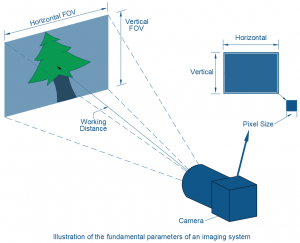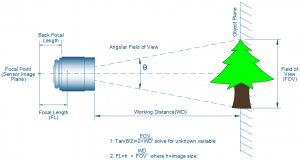Discovering Imaging Fundamentals
Imaging lies at the heart of various disciplines, be it photography, microscopy, or scientific research reliant on optical instruments. These fundamental concepts serve as the cornerstone upon which more intricate ideas are built. Field of view (FOV), working distance (WD), resolution, depth of field (DOF), sensor size (H), pixel size (s), and magnification (m) stand pivotal in understanding the capabilities and limitations of imaging systems. Whether capturing sweeping landscapes, exploring microscopic realms, or advancing scientific inquiry, mastering these concepts empowers users to optimize their equipment and achieve desired outcomes.

Visualization of Key Parameters in Imaging Systems
Exploring Essential Imaging Parameters
- Field of View (FOV): The extent of the observable world visible through an optical instrument like a camera or microscope at any given moment, typically expressed in degrees. It defines the angular extent of the scene that can be captured or observed.
- Working Distance (WD): The distance between the front optical surface of a lens or optical device and the object or surface being observed or imaged, indicating the distance from the lens to the focused object.
- Resolution: The minimum feature size of an object distinguishable by an imaging system, often measured in line pairs per millimeter. It denotes the system’s ability to resolve fine details or patterns, with higher spatial frequencies corresponding to finer details and higher resolution.
- Depth of Field (DOF): The range of distance in a scene, from the nearest to the farthest objects, appearing acceptably sharp in an image. Influenced by factors such as aperture size, focal length, shooting distance, and sensor size, DOF describes the area within which objects are in focus.
- Sensor Size (H): The active area size of a camera sensor, typically specified horizontally or vertically, influencing lens magnification required to achieve the desired FOV. Larger sensor sizes allow for capturing more light and detail, enhancing image quality and low-light performance.
- Pixel Size (s): Square-shaped units composing the sensor grid, with dimensions typically in micrometers. Pixel size affects various aspects of image quality, including resolution, sensitivity, and dynamic range, where larger pixels enhance light capture and low-light performance, while smaller pixels offer higher resolution at the expense of increased noise.
- Magnification (m): The ratio between sensor size and FOV, defining the lens magnification required to capture a specific field of view.

Illustration of a Fixed Focal Length Lens
Applying Imaging Fundamentals
Understanding these fundamental concepts lays the groundwork for a comprehensive grasp of imaging technology. From the broad field of view shaping our visual perception to the minute pixel size determining resolution, each term plays a vital role in shaping the final image or observation. Mastery of these concepts empowers practitioners across photography, science, and beyond to make informed decisions, whether selecting equipment, adjusting settings, or interpreting results. As imaging technologies progress, a solid understanding of these fundamentals remains invaluable, guiding practitioners towards greater feats of visual exploration and expression.
Contact Shanghai Optics today! We’d be more than happy to discuss your projects and how to best bring them to fruition.

